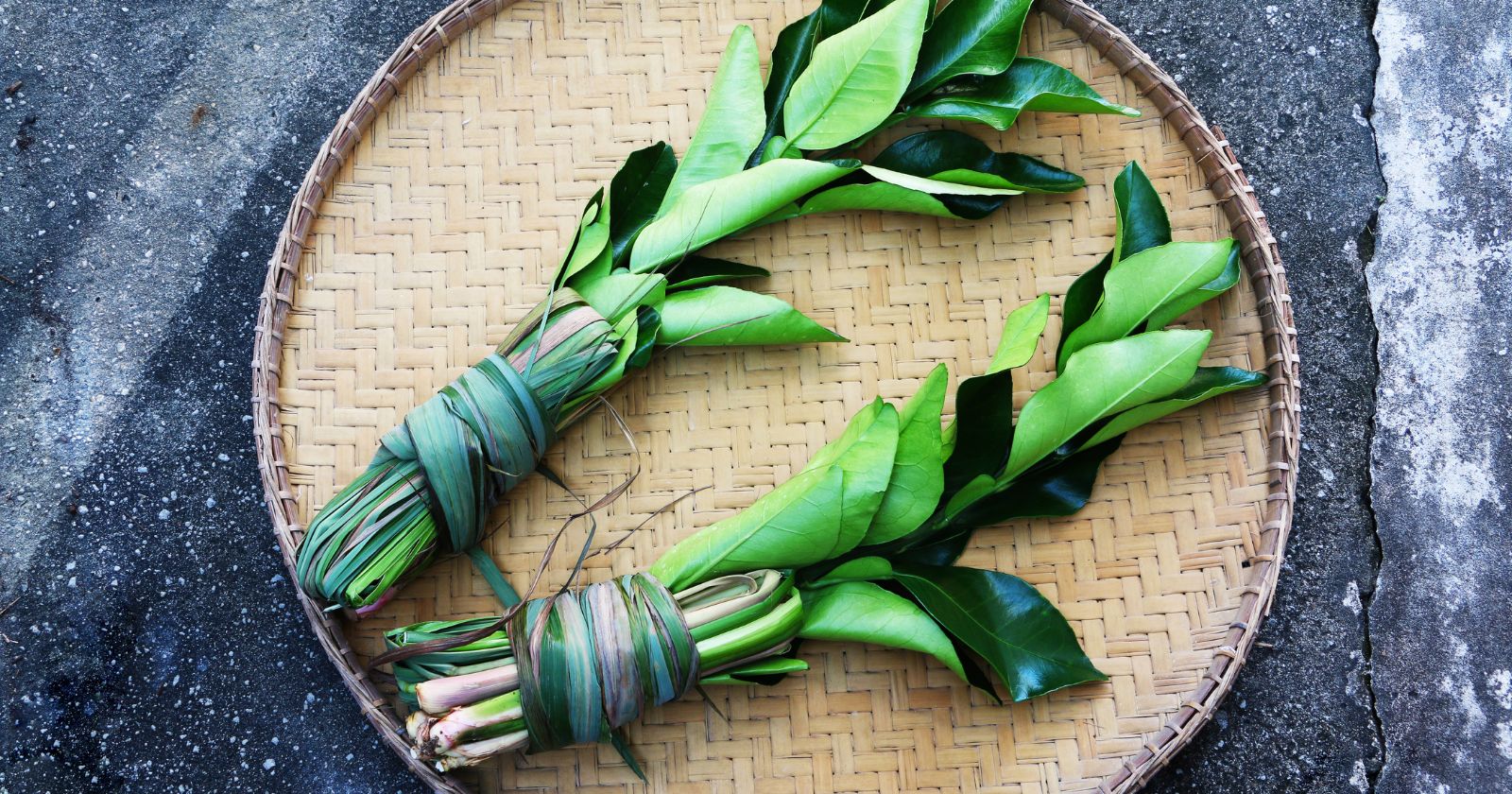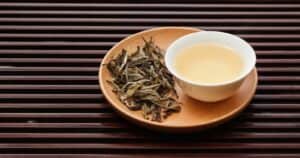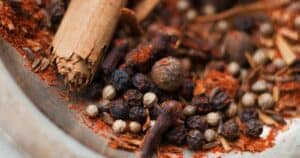Are you tired of bland dishes and looking to add a new flavor to your cooking? Look no further than Kaffir leaves! These aromatic leaves are an essential ingredient in Asian cuisine, but many are unfamiliar with incorporating them into their dishes.
In this article, we’ll cover everything you need to know about Kaffir leaves, from their origin to where to find them.
We’ll also provide tips on properly preparing and cooking with them so that you can add a burst of refreshing citrus and
What Are Kaffir Leaves?
Kaffir leaves are a popular ingredient in Southeast Asian cuisine, especially Thai dishes. They come from the Kaffir lime, a citrus fruit native to that region. The leaves have a unique flavor and aroma, adding a spiced-citrus taste to food. They enhance the fragrance of various chicken dishes and neutralize foul odors while cooking snails.
In addition to their culinary use, Kaffir leaves have some medicinal properties. They contain compounds traditionally used for treating various ailments such as muscle pain, headaches, and digestive issues. Consuming Kaffir leaves can also help boost metabolism, detoxify the body, and enhance overall health.
Kaffir leaves are not readily available in some parts of the world, but they can be found in Asian markets and some specialty stores.
They can be used fresh, dried, or frozen and are versatile ingredients in sweet and savory dishes. They pair well with coconut milk, lemongrass, and other aromatic herbs.
Traditional Uses of Kaffir Leaves in Asian Cuisine
Kaffir leaves are a popular herb extensively used in various traditional Asian cuisines. Whether you are enjoying a bowl of Vietnamese Phở, Indonesian Soto Ayam, or Thai Tom Yum soup, you are likely savoring the zesty flavor of these exotic leaves. In this article, we will dive deeper into the Traditional Uses of Kaffir Leaves in Asian Cuisine.
Kaffir Leaves in Vietnamese Cuisine
In Vietnamese cuisine, kaffir leaves are used primarily to add fragrance to chicken dishes and decrease the pungent odor when steaming snails. They are also added to soups, such as Phở, to provide a refreshing aroma and a zingy tang that complements the savory broth.
Kaffir Leaves in Indonesian Cuisine
Indonesian cuisine, especially Balinese and Javanese cuisine, utilizes Kaffir Leaves for preparing dishes such as Soto Ayam, chicken curry, chicken, and fish. Kaffir Leaves adds a robust citrusy aroma to the food, which further enhances its taste and adds tanginess.
Kaffir Leaves in Thai Cuisine
Kaffir Leaves are a staple ingredient in Thai cuisine and are used in many classic dishes, including Tom Yum Soup, Green Curry and Panang Curry, and Thai Fried Rice. Whole kaffir lime leaves are commonly used, and you can easily find them in most Thai markets. These leaves are full of flavor and create an irresistible aroma when cooked.
How to Source Fresh Kaffir Leaves
Looking for fresh kaffir leaves to add a unique flavor to your dishes? You can quickly source them from online stores such as Amazon, Whole Foods Market, ImportFood.com, US Citrus, and Grocery Thai.
These stores offer fresh kaffir lime leaves that can be shipped quickly within two days. You can also find fresh kaffir leaves in local Asian markets or specialty stores.
Kaffir lime leaves freeze well to be bought once and stored for future use. But why settle for just fresh kaffir leaves when you can have a constant supply of them? Here’s how you can do it:
- Choose fresh kaffir leaves that have no tears or discoloration.
- Wash them thoroughly and pat them dry with a paper towel.
- Place them in a resealable plastic container or bag.
- Label the container or bag with the date of freezing.
- Store in the freezer for up to six months.
When you’re ready to use frozen kaffir leaves, remove them from the freezer and add them to your dish without thawing.
How to Store and Prepare Kaffir Leaves
To store kaffir leaves, keep them in a plastic bag or container and store them in the crisper drawer of the refrigerator for up to a week. Remove the tricky part of the center rib before cooking with the leaves.
Fresh leaves should be bruised or crushed in hands before use to release their aromas. Kaffir lime leaves can also be frozen for up to a year in an airtight container.
Kaffir leaves are an essential ingredient in Southeast Asian cuisine, adding a distinct citrusy flavor to curries, soups, and sauces. To ensure that you always have fresh kaffir leaves on hand, it’s crucial to know how to store them properly. Here are some tips:
- Remove any damaged or wilted leaves before storing.
- Handle the leaves gently to avoid bruising or tearing them.
- Wait to wash the leaves until you are ready to use them.
- If you plan to freeze the leaves, blanch them for 30 seconds in boiling water and then rinse them in cold water.
- Label the container with the freezing date to ensure you use them before they lose flavor.
When cooking with kaffir leaves, it’s best to use them sparingly since they have a potent flavor. You can shred them into thin strips or chop them into small pieces. Here are some recipe ideas for using kaffir leaves:
- Thai green curry: Combine coconut milk, green curry paste, vegetables, and chicken or tofu in a pot. Add kaffir leaves and let simmer until the flavors meld together.
- Tom yum soup: Boil shrimp or chicken broth with lemongrass, galangal, and kaffir leaves. Add chili flakes and lime juice for a spicy, citrusy flavor.
- Stir-fry dishes: Add torn kaffir leaves to your favorite stir-fry recipe for extra flavor.
Benefits of Using Kaffir Leaves in Cooking
Kaffir leaves bring a unique and refreshing flavor to cooking. Not only do they add a citrusy tang to dishes, but they also provide several health benefits.
These leaves are great for promoting good oral and skin health, and they are a natural source of antioxidants that cleanse the blood and fight inflammation.
Kaffir leaves also contain vital nutrients such as vitamin A and carotenes essential in maintaining overall health.
Kaffir leaves have been used in traditional medicine to treat various conditions, such as headaches, stomachaches, and fever.
The leaves contain essential oils that have anti-inflammatory and antibacterial properties. These oils are also great for promoting relaxation and reducing stress levels.
In addition, kaffir lime leaves have been used to treat skin conditions such as acne and eczema due to their antibacterial properties.
Kaffir leaves can be used in various dishes, lending their unique flavor to stir-fries, curries, soups, and stews. They are trendy in Thai and Southeast Asian cuisine, where they are used to infuse coconut-based broths and fragrant fish curries with their citrusy flavor. They can also make teas, infused oils, and other culinary delights.
Adding kaffir leaves to your cooking can provide flavor and various health benefits. Whether you want to promote good skin and oral health or add a unique twist to your favorite dishes, these leaves are an excellent addition to any culinary arsenal.
Four Delicious Recipe Ideas Using Kaffir Leaves
Looking for delicious recipe ideas with kaffir leaves? Look no further! Here are four mouth-watering dishes you must try with kaffir leaves.
First, let’s start with the all-time favorite, Thai Green Curry with Kaffir Lime Leaves. This dish consists of juicy chicken or tofu cooked in spicy green curry paste, creamy coconut milk, and fragrant kaffir lime leaves. It is a perfect comfort food paired with steaming hot rice.
For those who prefer something a little bit lighter, try the Spicy Asian Tuna Dip. This refreshing appetizer is made with canned tuna mixed with mayonnaise, sriracha sauce, fresh lime juice, and finely chopped kaffir lime leaves. Serve with pita chips or fresh vegetable crudites for a healthy snack.
Tom Yum Soup is another simply irresistible dish. This tangy and spicy soup combines chicken or shrimp, lemongrass, galangal, and red chilies in a flavourful broth. To enhance its deliciousness, kaffir lime leaves, and fresh lime juice are added to balance the sourness.
Lastly, Kaffir Lime Leaf Chicken Skewers are perfect for a weekend BBQ party. The chicken is marinated with creamy coconut milk, soy sauce, garlic, and minced kaffir lime leaves. Then thread onto skewers and grill to perfection. It is simple yet always a crowd-pleaser for all ages.
Things to Keep in Mind When Cooking with Kaffir Leaves
Kaffir leaves are a flavorful addition to many dishes, but there are a few things to remember when cooking with them. To fully unleash their fragrant aroma, using these leaves to infuse curries, stir-fries, soups, or stocks is best.
Gently bruise or crush the leaves before adding them to your dish, which will help release their aromatic properties.
It’s important to note that kaffir limes have few seeds and little juice, so their flesh isn’t commonly used in recipes. When working with kaffir leaves, you’ll also want to remove the center rib before tossing them into your dish. Doing so makes it easier to enjoy the whole leaf without any difficulty.
To add kaffir lime leaves to salads or stir-fries, shred or tear them into small pieces after removing the center vein. This will allow their unique citrusy flavor to infuse the dish without overpowering the other flavors.
When pairing kaffir lime leaves with other ingredients, they pair well with coconut milk, lemongrass, and Thai chiles. However, they can also be used in various cuisines, from Southeast Asian to Caribbean to African cooking.
Just be sure to keep in mind their potency and flavor profile as you experiment with different dishes.
Kaffir Leaves Substitutes
Bay leaves, lime zest, lemon zest, lemongrass, basil, mint or coriander (cilantro), preserved lemon, curry leaves, lemon balm, lemon verbena, orange peel, and lime juice are some of the substitutes for kaffir leaves in cooking.
- When substituting kaffir leaves, bay leaves are a popular option as they have a similar pungent flavor and are commonly used in savory dishes. However, other substitutes can also add their unique flavors to the plate.
- Lime and lemon zest can add a citrusy flavor, while lemongrass can give a lemony taste.
- Basil, mint, or coriander can also provide a fresh herb flavor, and preserved lemon can give a salty and sour tang.
- Curry leaves, lemon balm, lemon verbena, orange peel, and lime juice are other substitutes that can add different flavors to your dish.
It’s important to note that while these substitutes can add great flavors to your cooking, they may not entirely replicate the unique taste of kaffir leaves.
Hence, it’s crucial to use the proper substitute according to the recipe, considering the balance and intensity of flavors.





